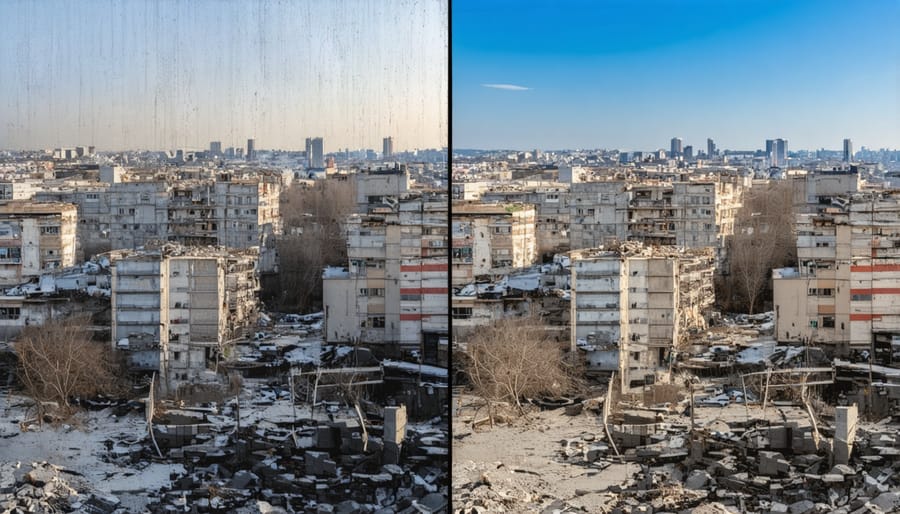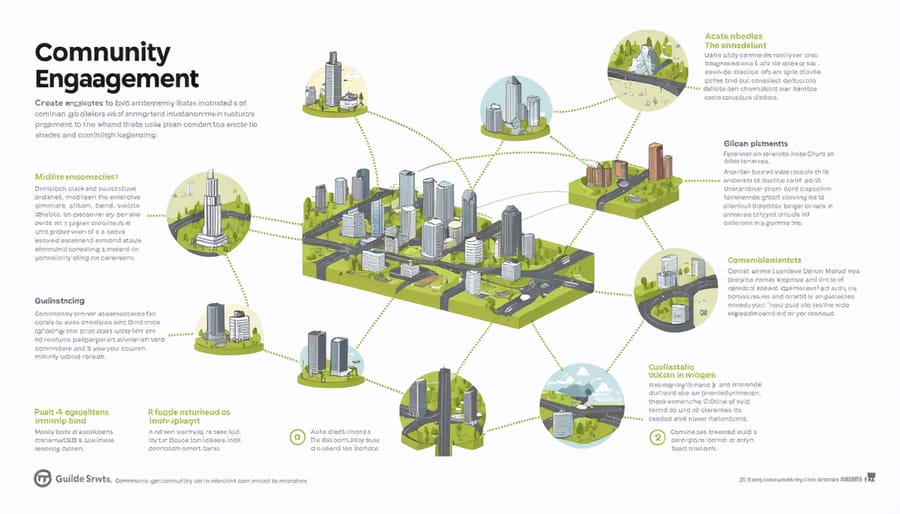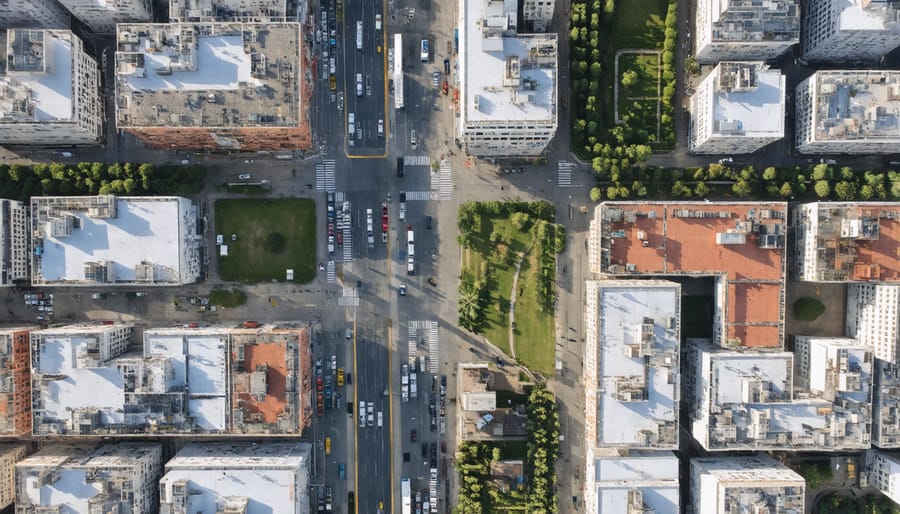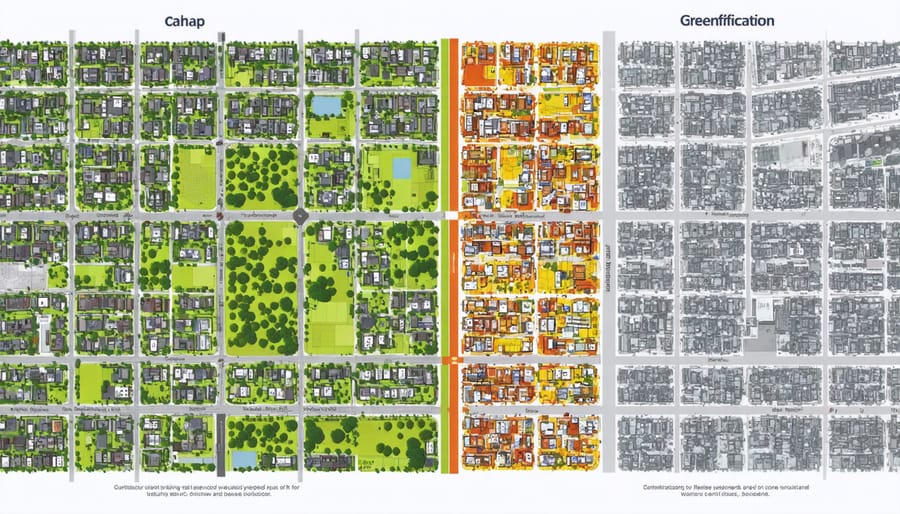Urban renewal and gentrification, while often used interchangeably in development discussions, represent fundamentally distinct approaches to neighborhood transformation. As cities across the globe grapple with aging infrastructure and changing demographics, understanding these differences becomes crucial for construction professionals and urban planners. Urban renewal typically emerges as a government-led initiative, characterized by systematic planning, public funding, and comprehensive infrastructure improvements. In contrast, gentrification manifests as a market-driven phenomenon, where private investment gradually transforms neighborhoods, often resulting in demographic shifts and economic changes.
For construction industry professionals, distinguishing between these processes is essential for project planning, community engagement, and sustainable development. The implications of each approach significantly impact everything from building permits and zoning regulations to community relations and project financing. Recent data from major metropolitan areas indicates that while urban renewal projects often involve complete structural overhauls and public amenity improvements, gentrification tends to focus on property-by-property upgrades driven by individual investors and developers.
This critical distinction shapes not only project scopes and timelines but also determines the regulatory frameworks, stakeholder engagement strategies, and social impact considerations that construction professionals must navigate in today’s complex urban development landscape.
Defining the Terms: Urban Renewal and Gentrification
The Evolution of Urban Renewal
Urban renewal has undergone significant transformation since its inception in the mid-20th century. Initially conceived as large-scale demolition and reconstruction projects, early urban renewal efforts often resulted in the wholesale clearance of neighborhoods deemed “blighted.” These post-war initiatives, while well-intentioned, frequently displaced established communities and disrupted social networks.
Modern strategic urban regeneration approaches have evolved to emphasize community preservation and sustainable development. Today’s urban renewal programs typically incorporate mixed-income housing, adaptive reuse of historic structures, and infrastructure improvements that maintain neighborhood character while enhancing living conditions.
The contemporary focus has shifted toward integrated development strategies that balance physical improvements with social and economic considerations. This includes implementing green building standards, creating walkable communities, and ensuring adequate public transportation access. Construction professionals now prioritize preservation where feasible, employing surgical intervention techniques rather than wholesale demolition, and incorporating community input throughout the planning and execution phases.

Understanding Gentrification’s Impact
Gentrification fundamentally transforms urban neighborhoods through a complex interplay of economic and social factors. When private investment flows into historically underserved areas, property values typically increase by 20-40% within five years, leading to significant demographic shifts. Research from the Urban Institute shows that this process often results in the displacement of long-term residents, with an average of 30% of original community members relocating within a decade.
The impacts of gentrification extend beyond housing markets. Local businesses face increased rents and changing consumer preferences, often forcing established enterprises to close or relocate. While new developments bring improved infrastructure and services, these advantages primarily benefit incoming residents. Studies indicate that original residents who manage to remain experience mixed outcomes: improved neighborhood amenities but decreased social cohesion and community networks.
Construction professionals should note that gentrification’s effects on the built environment include rapid property renovations, architectural style changes, and infrastructure upgrades. These physical transformations, while potentially improving building standards, can dramatically alter neighborhood character and create tension between preservation and progress. Understanding these dynamics is crucial for implementing more equitable development strategies that balance growth with community preservation.
Key Distinctions in Planning and Implementation
Policy and Regulatory Framework
Urban renewal typically operates within a structured legal framework, governed by specific legislation such as the Housing and Community Development Act and various local redevelopment laws. These frameworks often include provisions for public funding, eminent domain powers, and mandatory community consultation processes. Municipal authorities must follow strict guidelines for project approval, environmental impact assessments, and community benefit agreements.
In contrast, gentrification largely occurs through market forces and private investment, with fewer direct regulatory controls. While zoning laws and building codes apply to both processes, gentrification isn’t typically subject to the same level of public oversight or formal planning requirements. However, some cities have implemented anti-displacement policies and inclusionary zoning requirements to mitigate gentrification’s negative impacts.
The implementation of modern urban planning approaches has led to hybrid frameworks that combine elements of both processes. These newer policies often emphasize sustainable development, mixed-income housing requirements, and preservation of community character while facilitating necessary urban improvements.
Recent policy innovations include community benefits agreements, tax increment financing (TIF) districts, and affordable housing trust funds. These tools help balance development needs with community interests, though their effectiveness varies by jurisdiction and implementation approach.
Community Engagement Models
Community engagement represents a crucial differentiator between urban renewal and gentrification processes. Urban renewal typically involves structured community participation through formal channels, including public hearings, community advisory boards, and stakeholder consultations. These mechanisms allow residents to provide input on development plans, design elements, and implementation strategies before project initiation.
In contrast, gentrification often occurs with minimal community involvement, driven primarily by market forces and private investment decisions. This lack of formal engagement can result in displacement and community disruption without consideration for existing residents’ needs and preferences.
Successful urban renewal projects frequently employ multi-tiered engagement models, incorporating:
– Regular community forums and workshops
– Resident steering committees
– Local business alliance partnerships
– Digital feedback platforms
– On-site information centers
Construction professionals and developers implementing urban renewal initiatives are increasingly adopting collaborative planning approaches, where community input directly influences project scope and design. This participatory process helps ensure development aligns with neighborhood needs while maintaining cultural identity.
Studies indicate that projects with robust community engagement achieve higher satisfaction rates and face fewer implementation challenges. For instance, the involvement of local stakeholders in infrastructure planning can lead to more efficient project delivery and reduced opposition during construction phases.
Effective community engagement requires dedicated resources and expertise, but the investment typically results in more sustainable outcomes and stronger community support for development initiatives.

Case Studies: Successful Urban Renewal Without Gentrification
European Model: Barcelona’s 22@ District
Barcelona’s 22@ District stands as a prime example of sustainable urban renewal without widespread displacement, offering valuable lessons for construction professionals worldwide. Located in the formerly industrial Poblenou neighborhood, this innovative project has transformed 494 acres of obsolete industrial land into a thriving knowledge-intensive business district while preserving the area’s cultural heritage and social fabric.
The district’s success stems from its comprehensive planning approach, which mandates that 30% of renovated industrial land be dedicated to public facilities, affordable housing, and green spaces. This balanced development strategy has created approximately 93,000 new jobs while maintaining a mixed-income residential community, effectively countering the displacement effects often associated with large-scale urban renewal projects.
Key elements of the 22@ model include:
– Adaptive reuse of industrial heritage buildings
– Integration of cutting-edge sustainable infrastructure
– Mixed-use zoning policies that combine residential, commercial, and public spaces
– Strategic public-private partnerships for project financing
– Preservation of existing social networks and community structures
The project’s implementation has been particularly noteworthy for its innovative density bonuses, which allow developers to increase building height in exchange for providing public benefits. This approach has generated significant private investment while ensuring community returns, with over €180 million invested in public infrastructure improvements since the project’s inception in 2000.
Barcelona’s 22@ District demonstrates that urban renewal can successfully balance economic development with social equity when properly planned and executed. The model has become a blueprint for construction professionals seeking to implement sustainable urban transformation projects that benefit both developers and local communities.

North American Approach: Portland’s Pearl District
Portland’s Pearl District stands as a notable example of urban renewal that has successfully balanced development with community preservation. Once an industrial wasteland of abandoned warehouses and rail yards in the 1990s, this 100-acre district has transformed into a vibrant mixed-use neighborhood while maintaining much of its historic character.
The Portland Development Commission implemented a comprehensive renewal strategy that prioritized both infrastructure improvements and social sustainability. Key to this approach was the preservation of 30% of new housing developments for affordable units, ensuring economic diversity within the neighborhood. The initiative also maintained many original industrial buildings, converting them into loft apartments and creative spaces rather than demolishing them entirely.
Critical to the Pearl District’s success was the implementation of strategic public-private partnerships. The city invested heavily in public infrastructure, including the Portland Streetcar system and multiple green spaces, while private developers were incentivized to maintain architectural heritage and provide community benefits. This balanced approach helped mitigate displacement risks typically associated with gentrification.
The district now features a mix of converted warehouses, new construction, and public amenities, including Jamison Square and Tanner Springs Park. Employment opportunities have diversified beyond traditional industrial jobs to include technology firms, creative agencies, and retail establishments. The area maintains a strong arts presence through galleries and studios, preserving the cultural fabric that existed prior to renewal.
This transformation demonstrates how urban renewal can enhance a neighborhood while protecting existing community assets and preventing wholesale displacement, offering valuable lessons for construction professionals and urban planners nationwide.
Best Practices for Sustainable Urban Regeneration
Inclusive Design Strategies
Creating inclusive urban spaces requires a balanced approach that considers both physical infrastructure and social equity. Successful inclusive design begins with comprehensive community engagement, ensuring that existing residents’ voices are heard and their needs are incorporated into development plans. This approach aligns with modern urban resilience strategies while preserving neighborhood character.
Key strategies include implementing mixed-income housing policies, with specific quotas for affordable units in new developments. Design professionals should incorporate universal accessibility features, multi-generational spaces, and cultural preservation elements into their plans. Commercial development should prioritize local business retention through measures such as graduated rent increases and technical assistance programs.
Infrastructure improvements must be planned with existing community needs in mind, including enhanced public transportation connectivity, pedestrian-friendly streetscapes, and green spaces accessible to all residents. Successful projects often incorporate adaptive reuse of historic buildings, maintaining architectural heritage while meeting modern needs.
Financial tools such as community benefit agreements, local hiring requirements, and anti-displacement funds can help ensure that development serves existing residents. These mechanisms, when properly implemented, create a framework for sustainable growth that benefits both new and long-term community members while maintaining neighborhood diversity and character.
Economic Balance Measures
Maintaining economic diversity during urban renewal requires a balanced approach that combines policy measures with strategic development planning. Successful projects incorporate mixed-income housing requirements, with many municipalities mandating that 20-30% of new residential developments be allocated for affordable housing units. These initiatives help preserve neighborhood character while preventing wholesale displacement of existing residents.
Commercial space preservation plays an equally crucial role, with programs designed to protect local businesses through rent stabilization and targeted subsidies. Some cities have implemented commercial tenant protection policies, offering existing businesses first right of refusal on renovated spaces and graduated rent increases to ease the transition.
Financial mechanisms such as tax increment financing (TIF) districts can help fund community benefits, including workforce development programs and infrastructure improvements. When combined with sustainable development practices, these measures create a framework for inclusive growth.
Community benefit agreements (CBAs) have emerged as powerful tools for ensuring local economic interests are protected. These legally binding contracts between developers and community organizations typically include provisions for local hiring, living wage requirements, and support for small businesses. Some successful implementations have resulted in the creation of community-owned enterprises and cooperative housing models that maintain long-term affordability while fostering economic opportunity for existing residents.
While urban renewal and gentrification share some surface-level similarities, they represent fundamentally different approaches to urban development. Urban renewal typically involves planned, policy-driven initiatives aimed at improving infrastructure, public spaces, and community facilities while considering the needs of existing residents. In contrast, gentrification often occurs as a market-driven process that can lead to displacement and community disruption.
Looking ahead, the future of urban development will likely require a more nuanced and balanced approach that combines the best aspects of both processes. Successful urban transformation projects will need to prioritize community engagement, sustainable development practices, and equitable outcomes. Construction professionals and urban planners must focus on creating inclusive development strategies that preserve neighborhood character while upgrading necessary infrastructure.
Key considerations for future projects should include affordable housing provisions, local business protection measures, and phased development approaches that minimize displacement. The industry is increasingly adopting mixed-income development models and utilizing innovative financing mechanisms to ensure more equitable outcomes.
As cities continue to evolve, the distinction between urban renewal and gentrification will remain crucial for industry professionals. Success will be measured not just by physical improvements and economic growth, but by the preservation of community fabric and the creation of sustainable, inclusive urban environments that benefit all residents.

